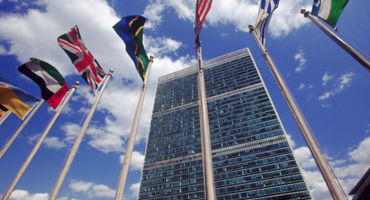Geopolitical investment implications
Trump’s first presidency offers few concrete clues about what a second administration would likely accomplish on the global stage. That’s because today’s geopolitical backdrop is vastly different, more complex, and more dangerous, and includes not only lingering COVID-19 economic and policy fallouts globally, but major wars in Europe, the Middle East, and potentially the Indo-Pacific. Each have implications for US foreign policy, global security, trade, climate, and other geopolitical factors.
For all the perceived noise, political upheaval, and policy dysfunction we navigated over those four years, the geopolitical environment that Trump’s administration faced was relatively tame — no major wars, no real threats of nuclear war or other significant military escalations involving great powers, no major terror attacks against the US or its allies comparable to the events of October 7, no persistent and state-sponsored attacks on global shipping and US military personnel, and no real challenges to US-led global security institutions including NATO, the QUAD, and others. COVID, of course, offered his administration a host of unique health, economic, and policy challenges but did not threaten national security interests. A Trump 2.0 administration, therefore, would be confronted with a significantly different world — and one where US interests, resources, and attention are already deeply stretched and increasingly challenged by the actions of China, Russia, Iran, North Korea, and other members of the so-called “axis of autocracies,” to say nothing of historically high political dysfunction in Washington.
Much of this new policy direction, too, will be dependent upon the skill of individuals who accept national security positions in a second Trump administration, and what these officials are able to accomplish at deeply entrenched institutions like the Pentagon, CIA, State Department, NSA and others. Suffice it to say, significant changes to US foreign policy will meet stiff internal resistance.
There is one area where Trump 1.0 priorities are likely to be instructive in positioning portfolios for his second administration. I believe Trump would focus first on trade, which has important foreign policy and geopolitical implications, and where a president would have wider latitude for action in a likely divided US Congress.
These trade impacts include increasing bilateral and geostrategic tensions with China as Trump — using the blunt tool of Sec. 301 (as was employed during his first administration) — vastly expands US tariffs both in size and scope aimed at Beijing, while targeting additional “strategic sectors” critical to great power competition with additional import and export controls. These plans may include Chinese IP theft and “state subsidies use” in a variety of sectors ranging from electric vehicles (EVs), to critical minerals, advanced electronics, semiconductors, pharmaceuticals, and other industries that have a “national security orientation”. If enacted, these expanded Trump actions will likely provoke similar retaliatory trade reactions from Beijing, so the negative direction of US-China relations is set to accelerate.
Trump may also levy more “targeted” trade restrictions “against everyone,” including key US allies in Europe and in the Indo-Pacific, particularly in industries that he deems important, either for domestic political or national security reasons. According to Trump confidants, this would likely include autos, solar panels, fiber-optic cables, and semiconductors. If this indeed comes to pass, from a national security perspective it would likely further strain US-Transatlantic relations, raise new questions about US military and diplomatic and security commitments among allies in Europe and Asia, and accelerate a fracturing global order. It would also introduce new incentives around the world to break from US security guarantees through rapid military build-ups, including (potentially) an increase in nuclear weapons capabilities.
US trade policy — and what it means for US foreign policy — would become more “transactional,” and less “strategic”. All of this would be welcomed and encouraged by senior leadership in China and Russia, both of whom view US military and economic ties with allies across Europe, the Indo-Pacific and elsewhere, as critical sources of US geostrategic strength. Beijing and Moscow, therefore, have strong national security incentives to promote these trade and related foreign policy developments in a second Trump administration, overtly and covertly.













Monthly Market Review — August 2024
A monthly update on equity, fixed income, currency, and commodity markets.
By
Brett Hinds
Jameson Dunn